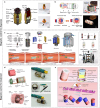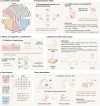Robotic wireless capsule endoscopy: recent advances and upcoming technologies
- PMID: 38816464
- PMCID: PMC11139981
- DOI: 10.1038/s41467-024-49019-0
Robotic wireless capsule endoscopy: recent advances and upcoming technologies
Abstract
Wireless capsule endoscopy (WCE) offers a non-invasive evaluation of the digestive system, eliminating the need for sedation and the risks associated with conventional endoscopic procedures. Its significance lies in diagnosing gastrointestinal tissue irregularities, especially in the small intestine. However, existing commercial WCE devices face limitations, such as the absence of autonomous lesion detection and treatment capabilities. Recent advancements in micro-electromechanical fabrication and computational methods have led to extensive research in sophisticated technology integration into commercial capsule endoscopes, intending to supersede wired endoscopes. This Review discusses the future requirements for intelligent capsule robots, providing a comparative evaluation of various methods' merits and disadvantages, and highlighting recent developments in six technologies relevant to WCE. These include near-field wireless power transmission, magnetic field active drive, ultra-wideband/intrabody communication, hybrid localization, AI-based autonomous lesion detection, and magnetic-controlled diagnosis and treatment. Moreover, we explore the feasibility for future "capsule surgeons".
© 2024. The Author(s).
Conflict of interest statement
The authors declare no competing interests.
Figures







Similar articles
-
Flexible and capsule endoscopy for screening, diagnosis and treatment.Expert Rev Med Devices. 2014 Nov;11(6):649-66. doi: 10.1586/17434440.2014.941809. Epub 2014 Aug 22. Expert Rev Med Devices. 2014. PMID: 25148269 Review.
-
Wireless technologies for robotic endoscope in gastrointestinal tract.J Med Eng Technol. 2012 Jul;36(5):242-50. doi: 10.3109/03091902.2012.673687. Epub 2012 May 18. J Med Eng Technol. 2012. PMID: 22594607
-
A Therapeutic Wireless Capsule for Treatment of Gastrointestinal Haemorrhage by Balloon Tamponade Effect.IEEE Trans Biomed Eng. 2017 May;64(5):1106-1114. doi: 10.1109/TBME.2016.2591060. Epub 2016 Jul 13. IEEE Trans Biomed Eng. 2017. PMID: 27416587
-
Wireless capsule endoscopy of the small intestine in children.J Pediatr Gastroenterol Nutr. 2015 Jun;60(6):696-701. doi: 10.1097/MPG.0000000000000782. J Pediatr Gastroenterol Nutr. 2015. PMID: 25782661 Review.
-
Wireless insufflation of the gastrointestinal tract.IEEE Trans Biomed Eng. 2013 May;60(5):1225-33. doi: 10.1109/TBME.2012.2230631. Epub 2012 Nov 29. IEEE Trans Biomed Eng. 2013. PMID: 23212312 Free PMC article.
Cited by
-
A novel network-level fused deep learning architecture with shallow neural network classifier for gastrointestinal cancer classification from wireless capsule endoscopy images.BMC Med Inform Decis Mak. 2025 Mar 31;25(1):150. doi: 10.1186/s12911-025-02966-0. BMC Med Inform Decis Mak. 2025. PMID: 40165262 Free PMC article.
-
Capsule robots for the monitoring, diagnosis, and treatment of intestinal diseases.Mater Today Bio. 2024 Oct 9;29:101294. doi: 10.1016/j.mtbio.2024.101294. eCollection 2024 Dec. Mater Today Bio. 2024. PMID: 39483392 Free PMC article. Review.
-
Superior gastrointestinal visualization and safety of detachable string magnetically controlled capsule endoscopy in patients on antithrombotic agents.Front Med (Lausanne). 2025 Apr 30;12:1578285. doi: 10.3389/fmed.2025.1578285. eCollection 2025. Front Med (Lausanne). 2025. PMID: 40370739 Free PMC article.
-
Continuous Biochemical Profiling of the Gastrointestinal Tract Using an Integrated Smart Capsule.Nat Electron. 2025 Jun 27:10.1038/s41928-025-01407-0. doi: 10.1038/s41928-025-01407-0. Online ahead of print. Nat Electron. 2025. PMID: 40842875 Free PMC article.
-
Frequency reconfigurable PIN diode-based Reuleaux-triangle-shaped monopole antenna for UWB/Ku band applications.Sci Rep. 2025 Feb 24;15(1):6555. doi: 10.1038/s41598-025-91108-7. Sci Rep. 2025. PMID: 39994395 Free PMC article.
References
-
- Basar MR, Malek F, Juni KM, Idris MS, Saleh MIM. Ingestible Wireless Capsule Technology: A Review of Development and Future Indication. Int. J. Antennas Propag. 2012;2012:807165. doi: 10.1155/2012/807165. - DOI
Publication types
MeSH terms
Grants and funding
LinkOut - more resources
Full Text Sources

